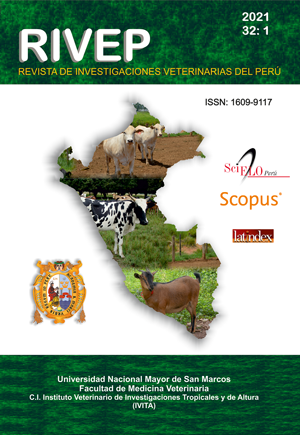Effect of five diets with different neutral detergent fibre and starch ratios on productive performance, ingestive ratio, and weight of digestive organs in guinea pigs (Cavia porcellus)
DOI:
https://doi.org/10.15381/rivep.v32i1.19495Keywords:
neutral detergent fibre, starch, productive performance, ingestive ratio, digestive organs, guinea pigAbstract
The aim of this study was to determine the effects of the ratio of neutral detergent fibre (NDF) and starch in the diet on productive performance, ingestive ratio and weight of the digestive organs of guinea pig (Cavia porcellus). Five isonitrogenous diets were prepared varying the NDF:starch ratio (PFA): 8.1, 3.5, 2.0, 1.3, and 0.8. In total, 160 28-day-old guinea pigs fed for seven weeks were used. The weight gain and the feed conversion index in the PFA 2.0 and PFA 1.3 groups were better than the other groups (p<0.05), together with a higher carcass performance (p<0.05). The weight gain in PFA 3.5 was greater than in the PFA 8.1 and PFA 0.8 groups (p<0.05). The relative intake of dry matter (DM) and the intake of NDF in the PFA 8.1 group was the highest; however, the digestible energy intake in PFA 8.1 was the lowest (p<0.05). Cecum weight was higher in PFA 8.1, PFA 3.5 and PFA 2.0 than in PFA 1.3 and PFA 0.8 (p<0.05). The DM intake in PFA 0.8 was the lowest. The results indicate that the optimal NDF:starch ratio in growing guinea pig diets is between 1.3 and 2.0.
Downloads
Downloads
Published
Issue
Section
License
Copyright (c) 2021 Manuel Paredes A., Emilio Goicochea P.

This work is licensed under a Creative Commons Attribution-NonCommercial-ShareAlike 4.0 International License.
AUTHORS RETAIN THEIR RIGHTS:
a. Authors retain their trade mark rights and patent, and also on any process or procedure described in the article.
b. Authors retain their right to share, copy, distribute, perform and publicly communicate their article (eg, to place their article in an institutional repository or publish it in a book), with an acknowledgment of its initial publication in the Revista de Investigaciones Veterinarias del Perú (RIVEP).
c. Authors retain theirs right to make a subsequent publication of their work, to use the article or any part thereof (eg a compilation of his papers, lecture notes, thesis, or a book), always indicating the source of publication (the originator of the work, journal, volume, number and date).



